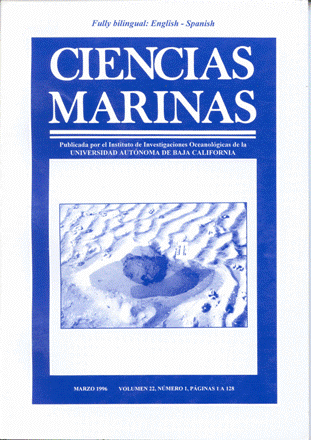Frond elongation rates of Macrocystis pyrifera (L.) AG. at Bahía Tortugas, Baja California Sur, Mexico
Main Article Content
Abstract
Growth rates of Macrocystis pyrifera fronds were measured in a control and a harvested bed in Bahía Tortugas, BCS. Measurements were taken every third day for the first 15 days after tagging and once again after 100 days. Growth rate in the control bed, as a function of frond length, follows a logarithmic relation, with maximum values in winter and minimum in summer. This pattern was consistent with the 100-day average growth rate, which varied from 12.8 cm/day in summer to 20.8 cm/day in winter. No significant difference was found in the percentage daily growth rate (E), ranging from 5.4% (spring) to 8.5% (winter). The standard growth rate (G) was not significantly different either, varying from 5.3% (spring) to 8.8% (winter), and the data obtained for average growth over 15 and 100 days were used to determine the seasonal variation, which is related to ambient temperature and nutrient availability. No adverse effects were found due to the experimental harvest, but the logarithmic relation changed to a linear one in spring and fall. Maximum values were also found in winter and autumn, with minimum values in spring and summer in both the 15 and 100-day average growth rates; average growth values after 100 days varied from 14.7 cm/day (spring) to 23.3 cm/day (winter). The E values ranged from 6.3% (spring) to 7.2% (winter). The G values varied from 6.9% (winter) to 10.1% (spring) and were significantly greater than those of the control bed. Considering the data obtained in this study, I suggest future experiments to validate the results in order to propose additional regulations for sustaining the harvest of the M. pyrifera kelp beds in the southern region of their distribution in Mexico.
Downloads
Article Details
This is an open access article distributed under a Creative Commons Attribution 4.0 License, which allows you to share and adapt the work, as long as you give appropriate credit to the original author(s) and the source, provide a link to the Creative Commons license, and indicate if changes were made. Figures, tables and other elements in the article are included in the article’s CC BY 4.0 license, unless otherwise indicated. The journal title is protected by copyrights and not subject to this license. Full license deed can be viewed here.

